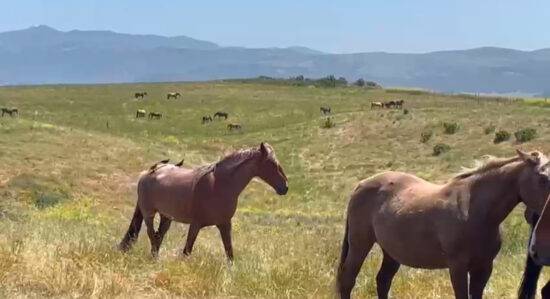Autumn
2008 Red Roan Quarter Horse Mare
Type of Rescue: Animal Control Surrender
Intake Date: 10/18/2023
Adoption Date: 4/4/2024
Length of Time with SAFE: 6 months
ADOPTED!! by Freedom Reigns Sanctuary
Autumn arrived at SAFE after a tumultuous past. She was part of a large Animal Control seizure and was sent to auction with a foal at her side. The two were separated, and eventually Autumn was sold to someone near Mt. St. Helens. A barn fire led to her escape, and she ran free for seven months before she was caught againp. Following that, she was given to a trainer who planned to gentle her, but after only a very brief period of time together, the trainer’s health issues led to her reaching out to SAFE. When she arrived at SAFE Autumn was extremely afraid of people. Over time she did learn to tolerate humans feeding her and cleaning her paddock but touching her was out of the question. When she began to show signs of aggression, we had to consider options available for Autumn’s future. Training could have been continued but it most likely would have taken years for her to reach the point she would have been adoptable. There was no guarantee that even with time she would be comfortable around people. Given her age, and the time and staff hours probably needed to train her, this was not a good choice. Fortunately, another option became available when we learned that a wild horse sanctuary in California could be a permanent home for Autumn. There, Autumn could roam as a wild horse. Because the sanctuary has experience with wild horses like Autumn, she will continue to receive necessary veterinary care. We are grateful that Autumn has a forever home in a place well-suited for a horse that pretty much wants to just be left alone.
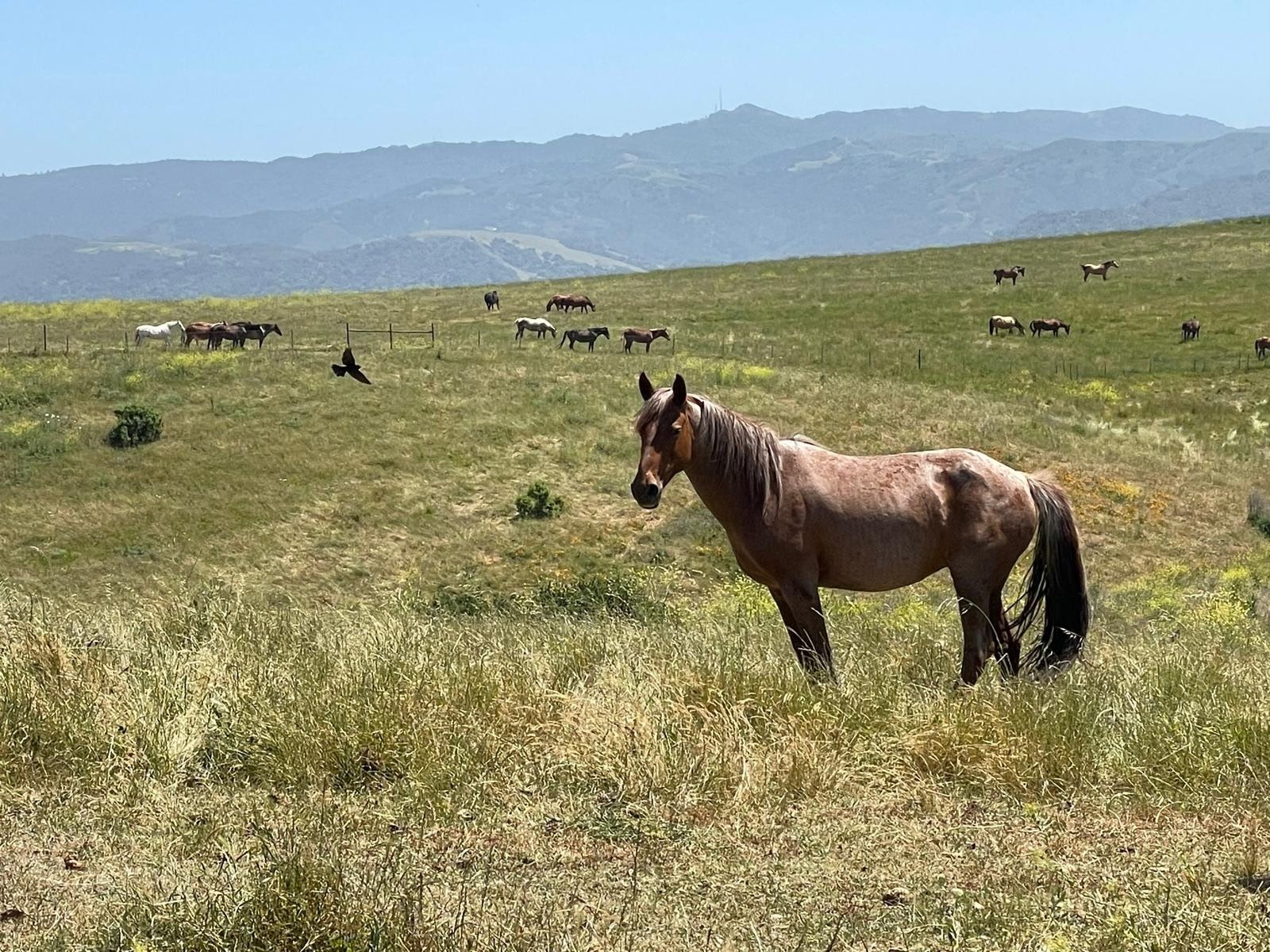
Free Forever, Autumn
We will choose to remember Autumn this way—with the sun shining on her and sparrows landing gently on her back.
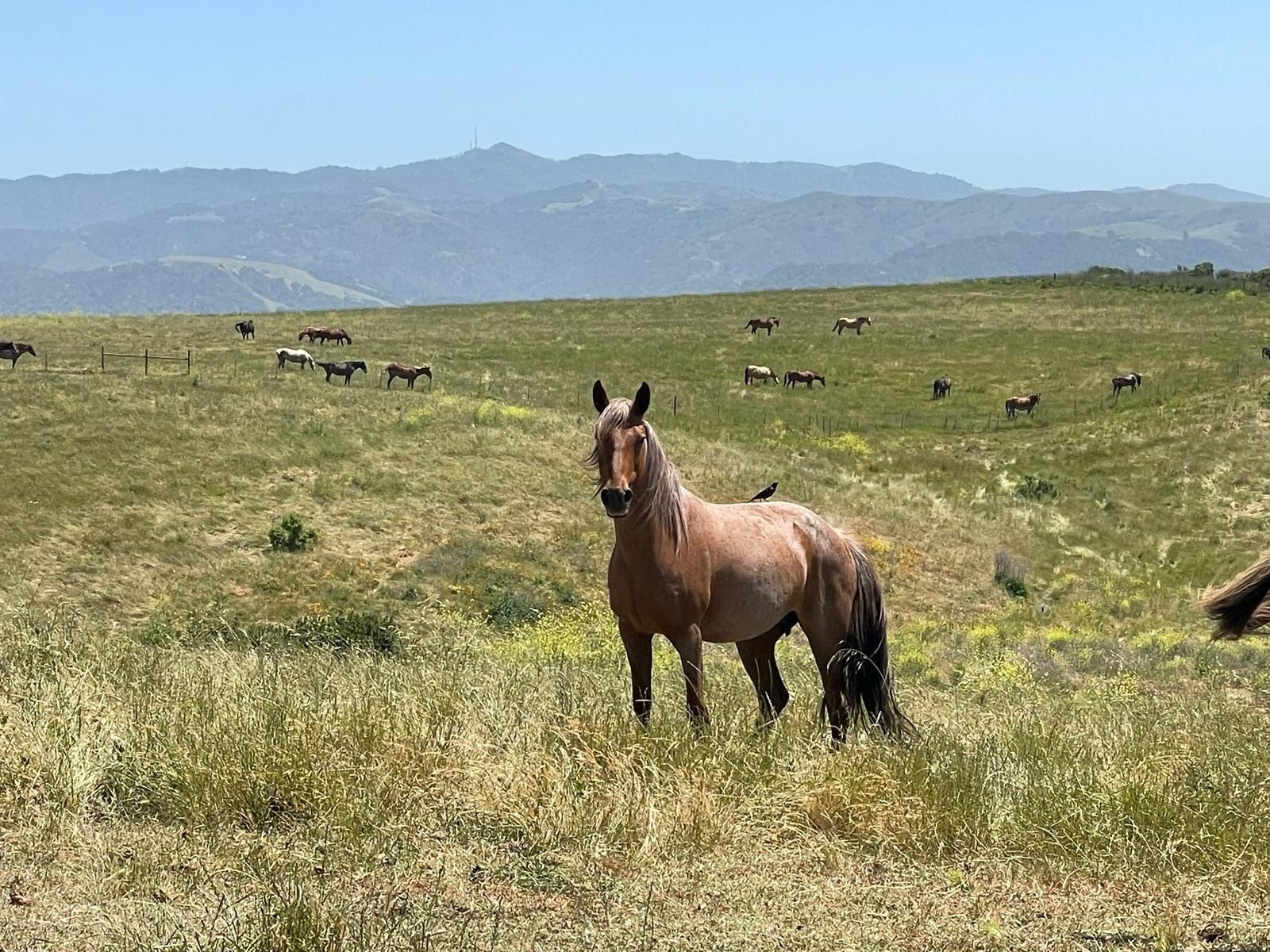
Autumn Running Free
For the last several months, Autumn has been settling into her life at Freedom Reigns. After passing her intake quarantine, she was introduced to a small herd, and began her new life — free to be as wild a horse as her spirit wanted. To see her roaming the hills with her friends, with the wind rustling her hair and the sun on her back, we are once again filled with immense gratitude to Freedom Reigns for helping horses like Autumn have a comfortable place to call home.
SAFE Horse Rescue: Autumn’s Journey
 The goal of any animal rescue organization is to help their charges return to the happy, healthy individuals that nature intended them to be.
The goal of any animal rescue organization is to help their charges return to the happy, healthy individuals that nature intended them to be.
It’s a mission that the volunteers at SAFE Horse Rescue in Redmond have successfully completed more than 300 times over the past couple of decades.
So, when they took Autumn off the trailer, they had no idea they would wind up with a life-or-death dilemma like they had never faced before.
Now, Autumn is on another trailer. She’s on her way to meet a new herd, where she’ll get to live out the rest of her life as far away from people as she can get.
LISTEN TO THE ENTIRE STORY at https://www.nwnewsradio.com/episode/040924–0/
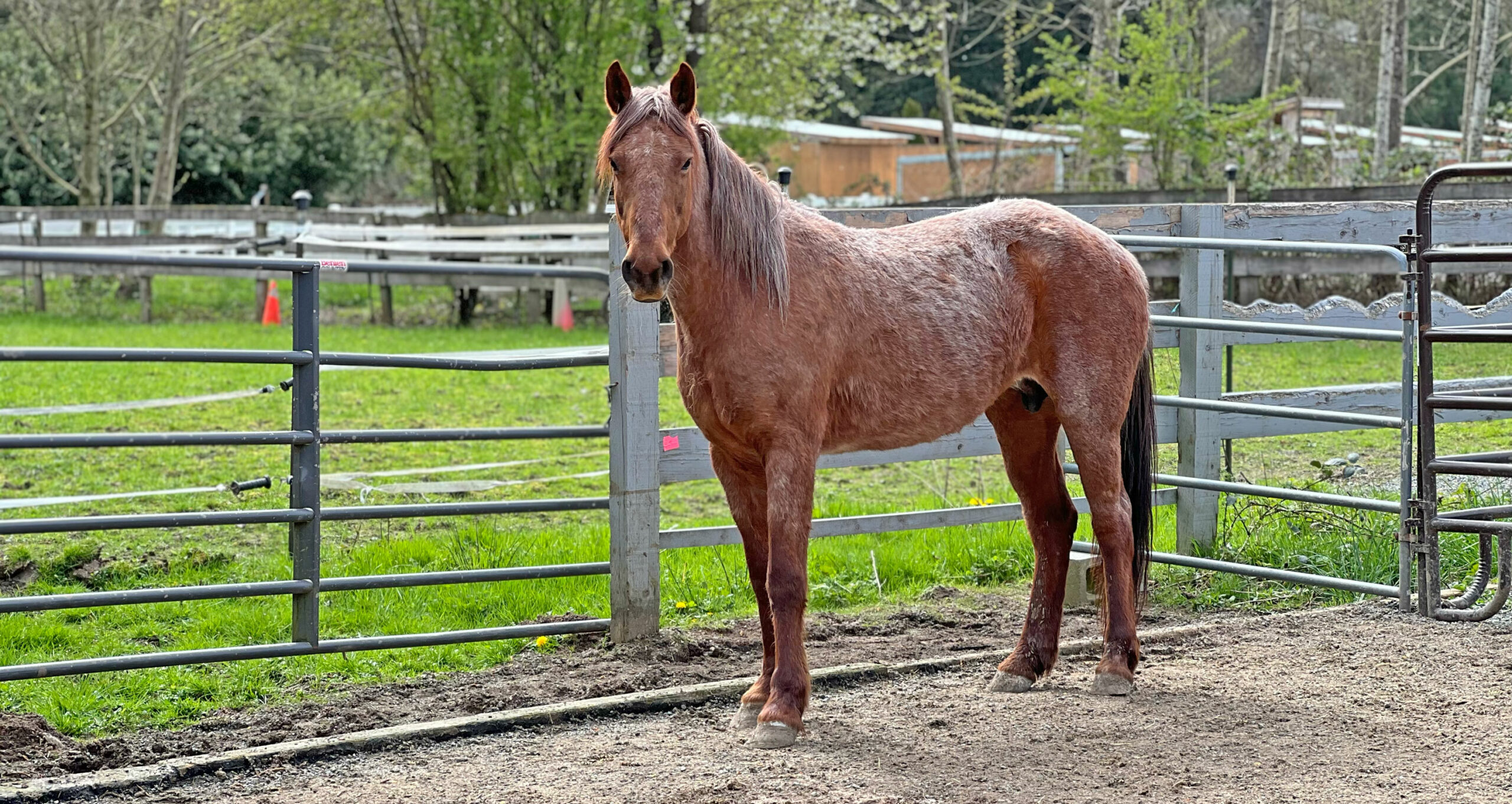
Autumn Will Soon Run Free
SAFE takes in a lot of unhandled, untouchable horses…mostly because a lot of unhandled, untouchable horses end up at rescues. It’s not against the law to let a young horse grow up without giving it an education, but uneducated young horses can grow up to be unwanted older horses when they get bigger…and more dangerous. Horses are generally good natured creatures, which is why past mistakes can be overcome with patient, consistent handling and training. We’ve had a ton of success in this particular arena. Sometimes this place feels more like a reform school than a rescue…but that’s a topic for another day.
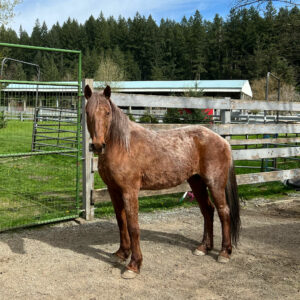 Autumn was left to grow up without an education, and this was made worse by her extreme fear of humans. She lived through some pretty challenging circumstances before she arrived at SAFE, so in some respects, her fear was understandable. What we couldn’t understand was why that fear didn’t seem to diminish after months in our care. Autumn did make some progress…she got accustomed to people coming into her paddock with hay or grain, and she tolerated her area being cleaned daily. But touching her was out of the question, as far as she was concerned. And as she became more comfortable at SAFE, she didn’t get curious about us, or more trustful…she started displaying little flashes of aggression. This was not a good sign.
Autumn was left to grow up without an education, and this was made worse by her extreme fear of humans. She lived through some pretty challenging circumstances before she arrived at SAFE, so in some respects, her fear was understandable. What we couldn’t understand was why that fear didn’t seem to diminish after months in our care. Autumn did make some progress…she got accustomed to people coming into her paddock with hay or grain, and she tolerated her area being cleaned daily. But touching her was out of the question, as far as she was concerned. And as she became more comfortable at SAFE, she didn’t get curious about us, or more trustful…she started displaying little flashes of aggression. This was not a good sign.
There comes a point in horse training where you have to weigh your options. Could we get through to Autumn? Probably…but it could take a very, very long time. Autumn is one of 30 horses here at SAFE and every horse on the property requires some degree of regular handling or training to prepare them for adoption. Our resources for horsemanship are not unlimited. Then there’s her age to consider. We’ve estimated Autumn to be 20 years old. We could spend five years working through her issues and have an adoptable horse who is now 25. Finally, you have to think about what the training experience is going to be like for her. Should we subject an unusually frightened horse to the process of being gentled and trained? Would the extensive handling needed to educate her be difficult or uncomfortable for her? Sometimes you have to ask the horse, and Autumn had already made herself pretty clear: she wanted us to leave her alone.
As much as we hated the thought of putting Autumn down, we knew it was a responsible choice that was in her best interest. But Autumn’s story took an unexpected turn. With the help of Jen Reid of Best Friends Animal Society and Elaine Nash of Fleet of Angels, a wild horse sanctuary offered us a lifeline. Autumn will live out her days in the company of other horses, roaming free over acres of land, and with minimal contact with humans. She’ll be transported to this sanctuary next week.
Now you may or may not know this, but transporting horses across state lines is strictly regulated. Most states, including the one that Autumn is headed for, require a vet to draw blood and test for equine infectious anemia, an untreatable and potentially fatal disease. A horse must have a current certificate that says it tested negative for EIA before it can come into the state. As mentioned, however, Autumn can’t be touched so she certainly isn’t going to let us draw blood. So special arrangements had to be made by the state veterinarian to allow Autumn to be shipped to the sanctuary without a certificate. Immediately upon her arrival, she’ll be unloaded into a squeeze chute which will gently immobilize her so that a vet can draw blood and send it to be tested.
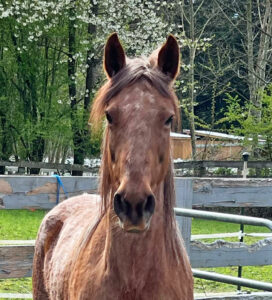 The squeeze chute is the key to providing the sanctuary’s horses with annual care like immunizations and deworming. These horses may be roaming free over thousands of acres, but they’re still being monitored to ensure that serious injuries don’t go unnoticed. They will humanely euthanize a horse that is suffering. There are no stallions in the herd so we don’t have to worry about Autumn being bred. And they are set up to make sure a horse like Autumn always gets enough to eat by feeding hay and grain as needed. Really, it’s the best of both worlds: Autumn will live free like a wild horse, but she will still be cared for.
The squeeze chute is the key to providing the sanctuary’s horses with annual care like immunizations and deworming. These horses may be roaming free over thousands of acres, but they’re still being monitored to ensure that serious injuries don’t go unnoticed. They will humanely euthanize a horse that is suffering. There are no stallions in the herd so we don’t have to worry about Autumn being bred. And they are set up to make sure a horse like Autumn always gets enough to eat by feeding hay and grain as needed. Really, it’s the best of both worlds: Autumn will live free like a wild horse, but she will still be cared for.
It’s important to understand how lucky we are to have been given this opportunity for Autumn. We were able to connect with individuals doing rescue on a national level, who were willing to help us because of SAFE’s good standing in the rescue community. It was hugely fortunate that the sanctuary not only had a place for Autumn but were also willing to talk through our concerns about what her life would be like moving forward. This does not change how we view humane euthanasia; we still feel strongly that it is a responsible and kind choice for many horses, and certainly far preferable to neglect, mistreatment, or suffering. We’re not likely to get another opportunity like this one. We are just so grateful that it has worked out so well for Autumn.
Thank you to Bill V and Judy W for donations to cover the cost of hauling Autumn to her new home!
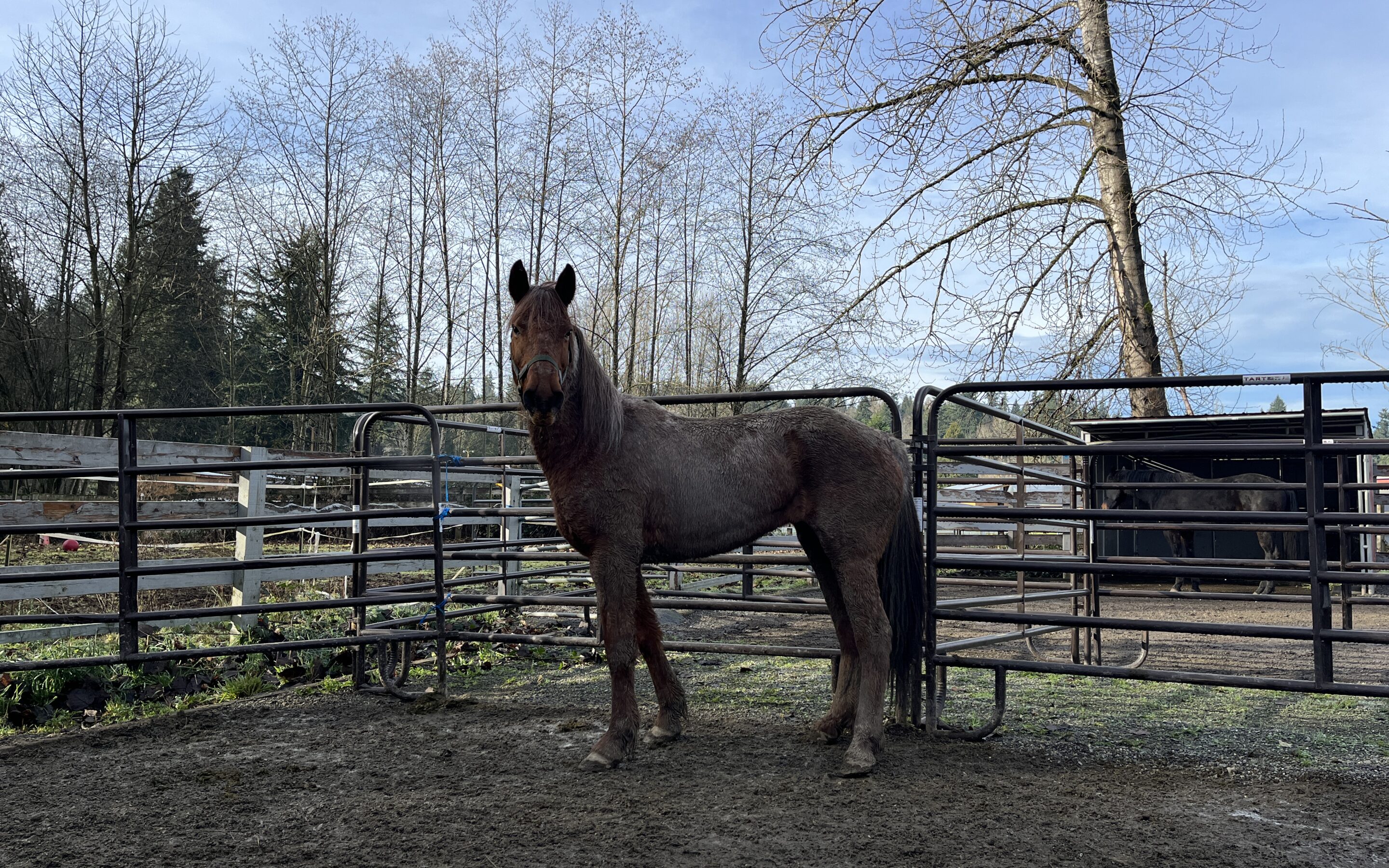
Autumn Beginning to Settle
If this image had a sound, it would be a ferocious snort. Even from a respectful distance, Autumn remains incredibly wary. It is clear that this girl has some serious trust issues, and while we knew she would need time, we always wish we could fast forward to the part where she has an understanding that we’re not out to get her.
There have been areas of progress, to be sure. She was a picky eater from day one, refusing to touch her hay if there was even the slightest chance a human was nearby and watching her. Because she was so thin, we hoped to help add calories (not to mention vitamins) with a grain mash as well, but this shyness to eat made it difficult for us to tell which grain — if any — she enjoyed. “Just put them in separate pans so you can keep track of what she likes,” you might say, to which we would reply that, while we did try that, sometimes the sneaky crows would swoop down and ruin our study. We couldn’t observe her directly, so the only choice was to leave her alone with the grain and hope that we could gain enough information from what she left to build a meal plan that worked for her.
And to our delight, she did begin to eat grain. At first, she requested it dry, and while we typically wet down all of our grain to avoid episodes of choke, we will on rare occasion make an exception. Then, as she grew a bit more comfortable, she began to eat a mash, which meant we could feed her larger quantities. Even still, she will wait far removed from her food while it is being delivered, her restraint based more in fear than in manners. But we are just happy she is eating more regularly, for a horse who doesn’t eat is as unnatural as one who doesn’t breathe.
Feeding her hay has still been quite a challenge. In an ideal world, she would eat out of the haybag that hangs at the back of her shelter, keeping her hay dry and elevated from the ground. Alas, the shelter is still a scary place for Autumn, who ventures in only occasionally, and even then in a tentative fashion. We have tried a range of musical hay nets in various spots around her paddock, but in nearly all cases there is some less than ideal circumstance surrounding the placement. Here, the hay that falls from the net creates a large pit of mud. There, the bag is unprotected from the elements, and Autumn often refuses wet hay. Most recently, we have been attempting to help her see the shelter as a safe space by feeding loose piles close to the entrance — close enough that she can make a quick exit if she should feel the need for one. Progress is slow, but it seems that she is growing more comfortable with the idea of spending more time in the shelter.
She is also gaining a bit more of an understanding around the routines here at SAFE. Trusted volunteers enter her paddock twice a day to pick, and though she snorts and avoids them, she can exist around them without completely losing her marbles. They, as instructed, ignore her entirely, showing her that they come in total peace, or even better, not even putting any meaning or expectation on their presence.
Autumn has even been known to take a few bites of hay in view of people on occasion, a pretty big change. She’s still leagues away from harassing you at her haybox, but we look forward to the day when we have to shoo her away.
Terry continues to spend patient time with her, working on earning her trust. Meanwhile, the rest of us keep our distance and root for her. Quietly. From afar.
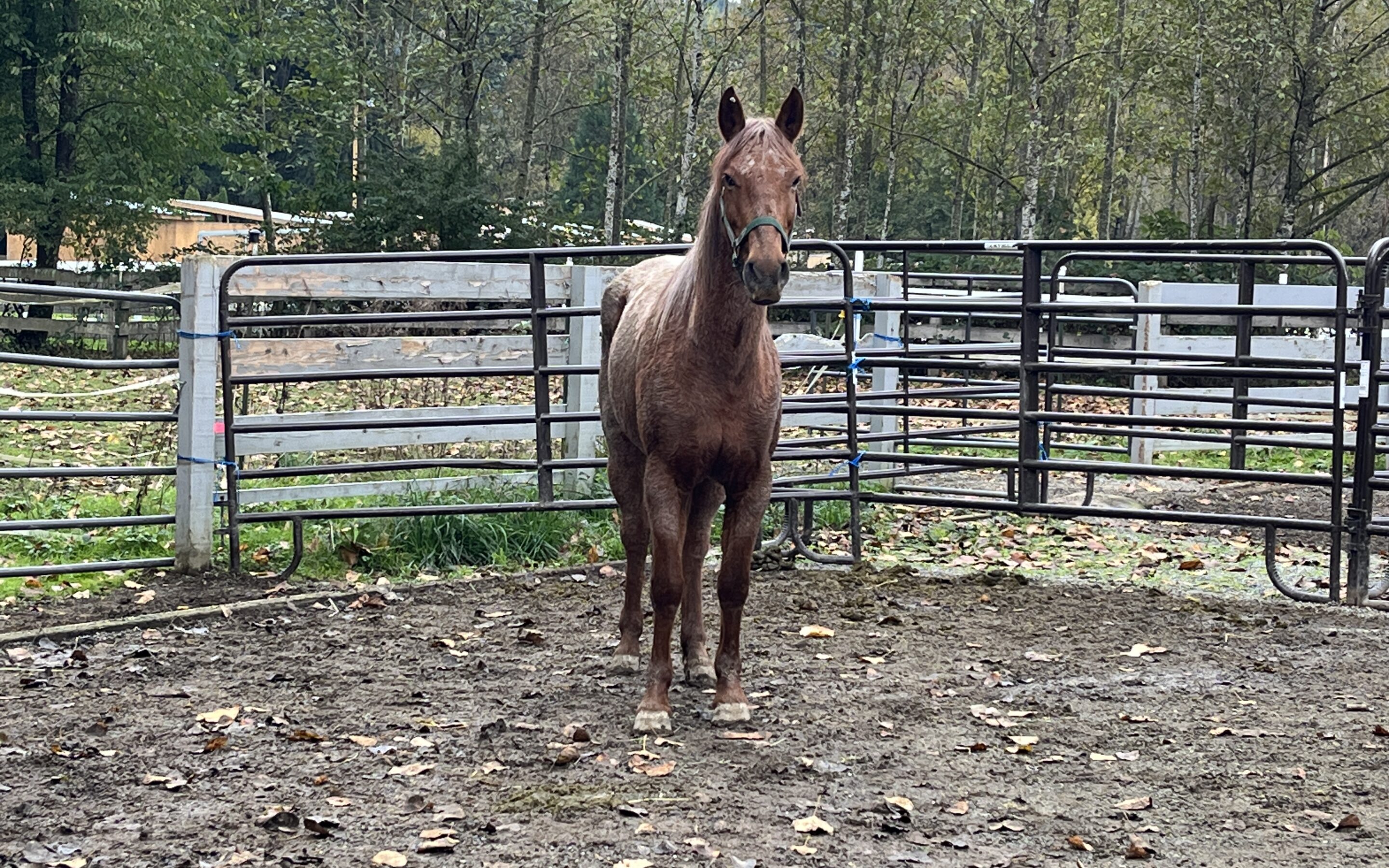
Autumn is Here
On the direct heels of Tanis’ passing several weeks ago, we received a call regarding a horse in need — another roan mare. It felt, admittedly, a bit like kismet.
We know that Autumn’s story starts with an Animal Control seizure. She was one of group of 44 horses taken from a hoarder in Lewis County. This was a horrific situation that involved dead horses, as well as mares and stallions pastured together on the property. After the seizure, Autumn and the rest of the survivors were sent to the auction at Toppenish to be sold. Autumn arrived with a foal at her side, who was taken off her and sold. Autumn was eventually purchased by an individual who brought her to Clark County.
In October 2022, there were wildfires around Clark County. We don’t know if Autumn was purposefully turned loose or if she escaped from her owner’s property, but either way, this mare ended up running loose on Mt St Helens. Incredibly, she lived in the wild for the next seven months. People would see her from time to time, but she could not be caught. Some hoped that she might join a group of wild horses that lived in the area. One good Samaritan was so concerned about Autumn’s welfare that she would drive her jeep up the mountain whenever she could to deliver hay for her to eat. But catching Autumn was still out of the question. Her kind benefactor described her as the most frightened horse she had ever seen. Finally, in May 2023, Autumn wandered down from the mountain and onto a horse property, where she was captured in a corral.
She was taken home by her benefactor, who spent the next four months trying to gentle her. She tried to get her to accept being touched by petting her from a safe distance with a stuffed glove on the end of a long tube. Eventually she was able to comb her mane, and even get a halter on her, but she realized she didn’t have the right set up to really give Autumn the help she needed. So in August, she found a trainer who was willing to take her on as a project, and gifted the mare to her. Unfortunately the trainer soon discovered that she herself was seriously ill, so she could not keep Autumn. She reached out to us, and with all this knowledge of the horse’s past, we agreed that the best place for her would be at SAFE.
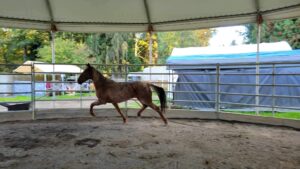 Autumn, aptly named for her resemblance to a deciduous leaf, clearly had a rather tumultuous past. We often talk about what is a SAFE horse, because with so many equines out there in need of rescue, there is no way for us to possibly intake them all. But a horse like Autumn — who was passed around for a long time, who was veritably untouchable, who, until at least nine years old, has never known a stable home — leaves us with no question. She is the description of a SAFE horse, one who has run out of options and has very few tools under her belt that make her adoptable. A horse like Autumn is one that our program was designed for, to keep her out of the auction pipeline. For Autumn, our hope is that the buck stops here, and SAFE is the second to last place she will end up (her future forever home being the very last).
Autumn, aptly named for her resemblance to a deciduous leaf, clearly had a rather tumultuous past. We often talk about what is a SAFE horse, because with so many equines out there in need of rescue, there is no way for us to possibly intake them all. But a horse like Autumn — who was passed around for a long time, who was veritably untouchable, who, until at least nine years old, has never known a stable home — leaves us with no question. She is the description of a SAFE horse, one who has run out of options and has very few tools under her belt that make her adoptable. A horse like Autumn is one that our program was designed for, to keep her out of the auction pipeline. For Autumn, our hope is that the buck stops here, and SAFE is the second to last place she will end up (her future forever home being the very last).
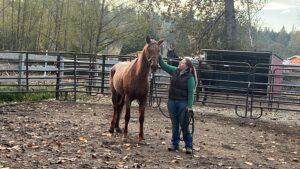 Autumn arrived at SAFE wearing a rope halter with a lead line dragging behind her. We were all very worried she would hurt herself with this non-breakaway halter. Since her arrival, Terry has been working with her 2–3 times a day, gaining a little trust and getting her to allowing her to get close enough to touch Autumn. After a few days, she was able to take off the rope halter and replace it with a much safer break-away halter. The following day, with a fair bit of time and patience, Terry was able to walk up to her and clip on to the halter. She was able to groom her face and down her neck, brush her mane, and treat her for lice (even when no lice are visible, we treat all new intakes to be safe). The next step will be to reach the point where the breakaway can come off.
Autumn arrived at SAFE wearing a rope halter with a lead line dragging behind her. We were all very worried she would hurt herself with this non-breakaway halter. Since her arrival, Terry has been working with her 2–3 times a day, gaining a little trust and getting her to allowing her to get close enough to touch Autumn. After a few days, she was able to take off the rope halter and replace it with a much safer break-away halter. The following day, with a fair bit of time and patience, Terry was able to walk up to her and clip on to the halter. She was able to groom her face and down her neck, brush her mane, and treat her for lice (even when no lice are visible, we treat all new intakes to be safe). The next step will be to reach the point where the breakaway can come off.
Autumn is incredibly nervous, and it is clear that she will need time to settle in. She has come to trust Terry enough to allow her to halter her, but it will still take a while before she will find the same trust in others. But with patience and time, we will get there.

